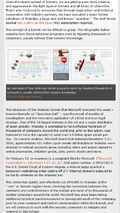Difference between revisions of "Cracking down on botnets"
| Line 10: | Line 10: | ||
|Link=http://blogs.technet.com/b/microsoft_blog/archive/2010/02/25/cracking-down-on-botnets.aspx | |Link=http://blogs.technet.com/b/microsoft_blog/archive/2010/02/25/cracking-down-on-botnets.aspx | ||
|Author=Tim Cranton, | |Author=Tim Cranton, | ||
|Type=Blogpost | |||
|Abstract=Botnets - networks of compromised computers controlled by hackers known as “bot-herders” - have become a serious problem in cyberspace. Their proliferation has led some to worry that the botnet problem is unsolvable. Under the control of a hacker or group of hackers, botnets are often used to conduct various attacks ranging from denial of service attacks on websites, to spamming, click fraud, and distribution of new forms of malicious software. | |Abstract=Botnets - networks of compromised computers controlled by hackers known as “bot-herders” - have become a serious problem in cyberspace. Their proliferation has led some to worry that the botnet problem is unsolvable. Under the control of a hacker or group of hackers, botnets are often used to conduct various attacks ranging from denial of service attacks on websites, to spamming, click fraud, and distribution of new forms of malicious software. | ||
Latest revision as of 11:02, 3 August 2015
(Publication) Google search: [1]
| Cracking down on botnets | |
|---|---|

| |
| Botnet | Waledac |
| Malware | |
| Botnet/malware group | |
| Exploit kits | |
| Services | |
| Feature | |
| Distribution vector | |
| Target | |
| Origin | |
| Campaign | |
| Operation/Working group | Operation b49 |
| Vulnerability | |
| CCProtocol | |
| Date | 2010 / 2010-02-24 |
| Editor/Conference | Microsoft |
| Link | http://blogs.technet.com/b/microsoft blog/archive/2010/02/25/cracking-down-on-botnets.aspx (Archive copy) |
| Author | Tim Cranton |
| Type | Blogpost |
Abstract
“ Botnets - networks of compromised computers controlled by hackers known as “bot-herders” - have become a serious problem in cyberspace. Their proliferation has led some to worry that the botnet problem is unsolvable. Under the control of a hacker or group of hackers, botnets are often used to conduct various attacks ranging from denial of service attacks on websites, to spamming, click fraud, and distribution of new forms of malicious software.
At Microsoft, we don’t accept the idea that botnets are a fact of life. We are a founding member of the Botnet Task Force, a public-private partnership to join industry and government in the fight against bots. Given the recent spread of botnets, we are getting even more creative and aggressive in the fight against botnets and all forms of cybercrime. That’s why I’m proud to announce that through legal action and technical cooperation with industry partners, we have executed a major botnet takedown of Waledac, a large and well-known “spambot.” The Wall Street Journal has a story on the case (WSJ subscription required).The concept of a botnet can be difficult to grasp. The infographic below explains how these nefarious programs work by hijacking thousands of computers, usually without their owners’ knowledge.
Bibtex
@misc{Lua error: Cannot create process: proc_open(/dev/null): failed to open stream: Operation not permitted2010BFR957,
editor = {Microsoft},
author = {Tim Cranton},
title = {Cracking down on botnets},
date = {24},
month = Feb,
year = {2010},
howpublished = {\url{http://blogs.technet.com/b/microsoft_blog/archive/2010/02/25/cracking-down-on-botnets.aspx}},
}